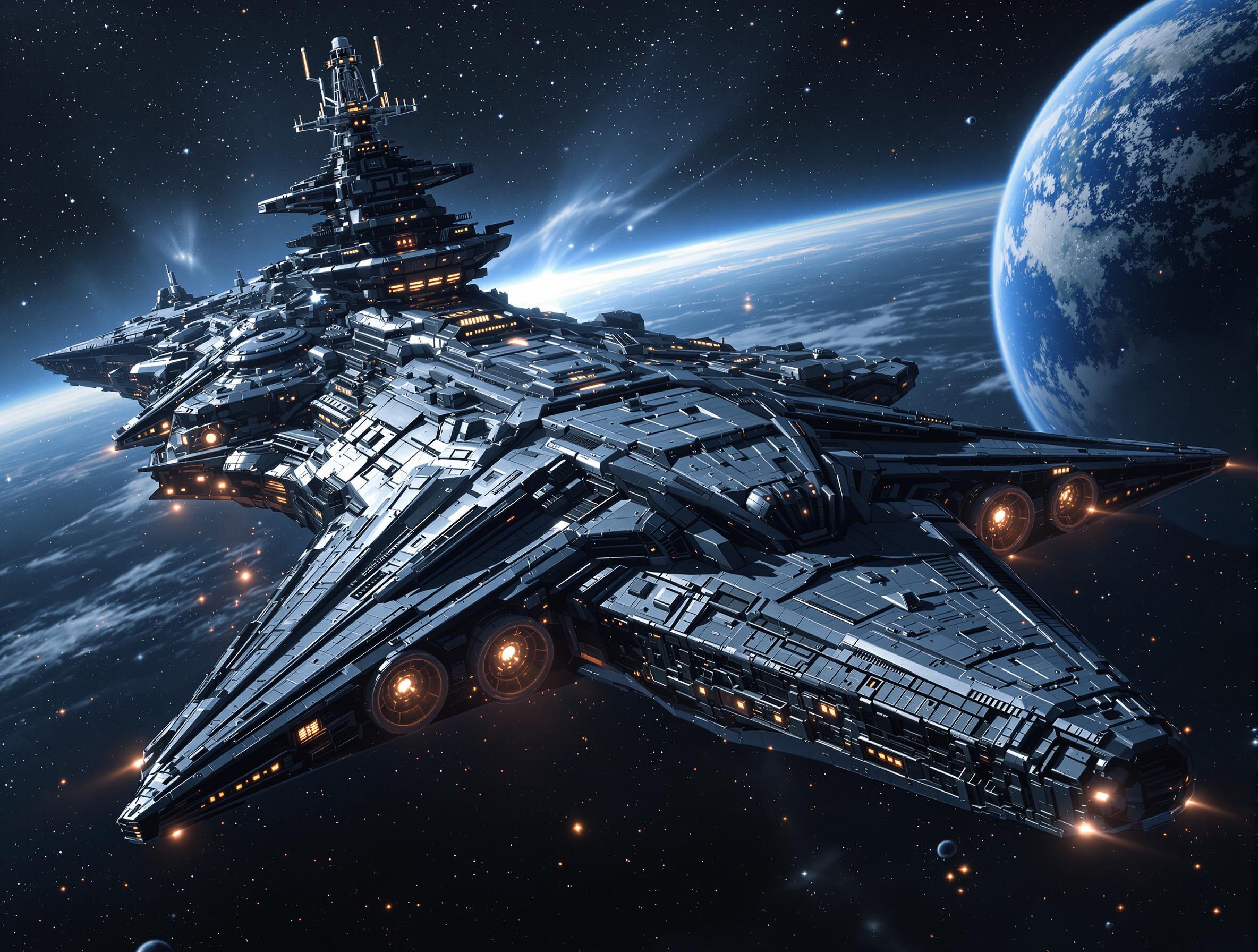I've always been fascinated by how science fiction merges dreams and science into one grand narrative. Every time I see the Star Destroyer in action, I can’t help but wonder how much of that vision is pure invention and how much could, even faintly, anchor itself in reality. The Star Destroyer, the colossal warship of the Galactic Empire in Star Wars, has become a global icon: a spacefaring giant embodying power and engineering at the edge of the imaginable.
What intrigues me is not just dreaming about it, but trying to bring that dream closer to reality by asking: what would it really take to build something like this? Not just in terms of size, but in materials, resources, technology, and energy. In this article, I push the reflection a step further, exploring what we can currently conceptualize—and what, perhaps one day, we might truly attempt to realize.
The Scale of the Colossus: A City in Space
The Imperial I-class Star Destroyer measures about 1,600 meters in length, with a width of roughly 750 meters and a height exceeding 250 meters. It’s a true space city, capable of hosting over 37,000 personnel, including officers, soldiers, pilots, and technical staff, while also transporting vehicles and starfighters.
The internal structure would consist of thousands of airtight compartments, hangars, command decks, and residential zones. Each compartment would need to ensure atmospheric containment, protection from cosmic radiation, and regulation of pressure and temperature.
Materials and Resources: Feeding a Giant’s Hunger
Building a Star Destroyer would require material resources on a scale never before seen in human history. Just the outer hull and structural framework alone would demand millions of tons of advanced metals. Conventional steel wouldn’t suffice: we’d need carbon nanotube-based alloys, graphene, and composite materials resistant to impacts and radiation.
The raw material needs would include:
Iron and specialty steel: millions of tons.
Titanium and aluminum: for lightweight structures.
Exotic materials: advanced composite alloys, ultra-resistant synthetic matter.
Crystals and semiconductors: for electronics and sensor systems.
The mining resources of a single planet might not be enough; exploiting asteroids and moons would be necessary. Industrial production alone would take decades—or even centuries—at current human capacities.
Propulsion: Moving a Giant Through Deep Space
In the saga, the Star Destroyer uses ion engines and hyperdrive systems for long-distance travel. In reality, ion engines of that magnitude do not exist. Today’s ion engines, like those used on NASA’s probes, generate only minimal thrust.
To propel a giant like this, we’d need nuclear thermal rockets or, looking further ahead, fusion engines or antimatter-based propulsion systems. For interstellar voyages, warp drives or similar concepts—such as the Alcubierre drive—remain purely theoretical and far beyond current technological reach.
Energy: The Lifeblood of a Behemoth
Powering such a vast vehicle would require energy reactors capable of generating terawatts of power. Traditional nuclear reactors wouldn’t be enough. We’d have to envision advanced fusion reactors or antimatter energy generators.
These reactors would need to supply energy for:
Life support systems.
Energy shields.
Armaments.
Communication and navigation systems.
Armaments and Defenses: Turbolasers and Shields in Real Terms
The Star Destroyer is armed with dozens of turbolasers, ion cannons, and other heavy weaponry. Our current technology is only beginning to test small-scale laser weapons with limited power. Scaling this up to Star Destroyer proportions would require unprecedented advances in thermal management and energy efficiency.
Energy shields, capable of deflecting or absorbing attacks, remain a purely theoretical concept with no current scientific validation.
Logistics and Life on Board: A Self-Sustaining Ecosystem
Sustaining tens of thousands of people in space demands a fully closed and autonomous ecosystem. The ship would need:
Complete air and water recycling systems.
Hydroponic or artificial greenhouses for food.
Advanced medical facilities.
Waste recycling systems.
This model would be an amplified version of the International Space Station, with exponentially greater complexity.
Economic and Industrial Cost: A Planetary Project
The cost of such a project would be astronomical. Speculative estimates suggest that building a similar spacecraft could cost trillions of dollars. Beyond the financial aspect, it would require planetary—or even interplanetary—industrial coordination, with production chains spanning Earth, the Moon, and nearby asteroids.
Measuring the Impossible
The Star Destroyer isn’t just a massive ship: it’s a visual representation of absolute power, a monolith of engineering that defies the known limits of physics and logistics.
But perhaps what fascinates most is not its lethal, warlike nature, but its essence as a microcosm—a floating concentration of knowledge and technology. After all, it’s a fiction, a product of imagination. Yet think of Jules Verne: wasn’t he considered a visionary when he imagined the impossible at a time when technology offered no concrete foothold? His vision of a lunar journey, for instance, was conceived when neither the concepts nor the technologies existed to even suggest that possibility.
We, on the other hand, now possess theoretical concepts and technologies that have already shaped the idea of a Star Destroyer. So, if the foundations exist, how close—or far—might we be from turning it into reality?
In this ongoing dialogue between fantasy and reality, one powerful truth emerges: the desire to push beyond, to build not just weapons or spacecraft, but collective dreams that redefine our place in the universe.








Leave a Comment